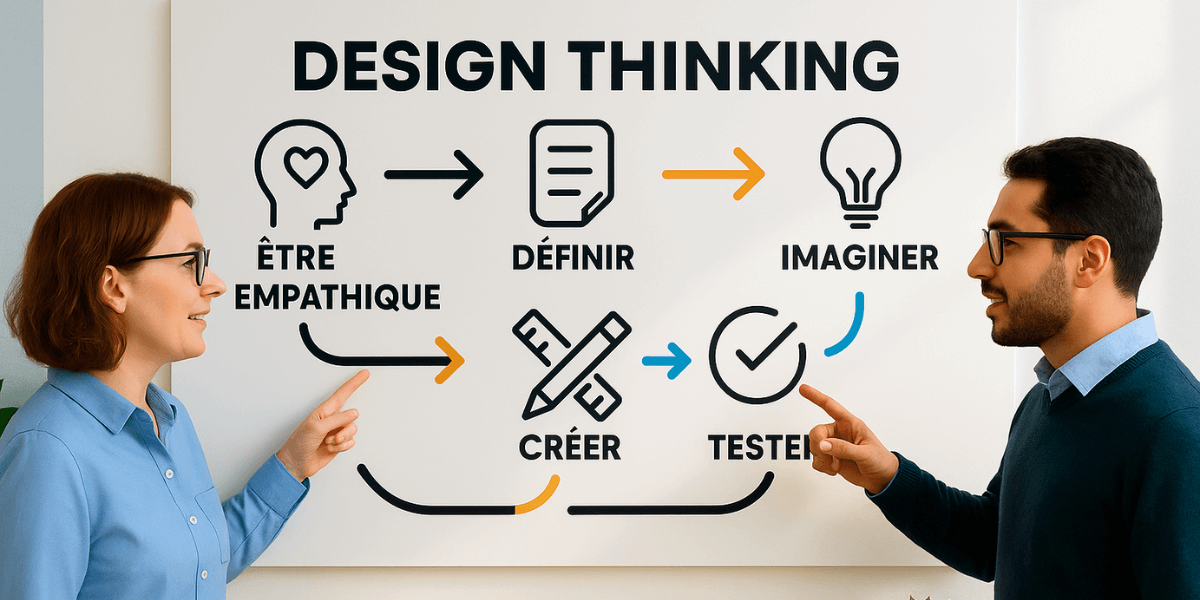Home > Design Thinking: Innovating with Empathy and Creativity
What if your most innovative ideas were failing simply because they don’t meet real needs? Design Thinking offers a powerful approach to innovation by putting the user at the center of every decision. Unlike traditional methods, it doesn’t start with a solution, but with a real, human problem. The result: better-designed products, more effective services, and an ROI that can exceed +200%. By combining empathy, creativity, and rapid experimentation, Design Thinking turns vague intuitions into concrete, tested solutions. In this article, discover the keys to this agile method, its 5 stages, essential tools, and the pitfalls to avoid to turn ideas into success.

Imagine cooking a dish without knowing your guests’ tastes. Design Thinking is exactly that: a creative recipe where the user becomes the chef. This human-centered method turns problems into tangible solutions through constant back-and-forth between observation and experimentation. It blends deep analysis with concrete testing.
Three key ingredients make it boil: Empathy (watching nurses at work to improve a hospital), iteration (prototyping 10 app versions before finding the right one), and co-creation (bringing marketing, engineers, and clients to the same table). Cross-functional collaboration becomes your best ally here!
The result? Companies using this approach can see their ROI soar by up to 107%. A few years ago, take Airbnb: by redesigning its user experience through Design Thinking, the platform multiplied its revenue by 5 in one year.
Born in the 1960s among rebellious designers, the concept boomed in 1991 with IDEO. Today, it goes beyond physical products, for example:

The Stanford method turns innovation into a structured adventure:
| Aspect | 5-Step Version (Stanford) | 7-Step Version (Rolf Faste) |
|---|---|---|
| Key steps | 1. Empathy 2. Define 3. Ideate 4. Prototype 5. Test | 1. Define 2. Research 3. Ideate 4. Prototype 5. Choose 6. Implement 7. Learn |
| Advantages | Agile structure Beginner-friendly User experience-focused | More complete process Includes post-test analysis Better solution validation |
| Drawbacks | Lacks analytical depth Risk of skipping result analysis | Steep learning curve Less suited to fast-paced projects |
| Average duration | 2–6 weeks | 6–12 weeks |
| Best use case | UX/Service design projects Agile startups | Complex projects Large organizations |
Watch out for common pitfalls! 68% of failures come from rushed empathy or hasty testing. Every step is crucial and lays the foundation for the next—each one is a building block for success.
For Swiss SMEs seeking efficiency: a condensed version. Combine the define and ideate phases to cut to the chase. A Lausanne-based scale-up recently mixed Design Thinking with Lean Startup. The result: time to market reduced by 40% thanks to 3-day sprints and daily paper prototyping.
Which approach to choose? It all starts with your current priority: saving time? Improving quality? Boosting collaboration? More and more Swiss companies combine multiple methodologies (47% according to a European study). The key? Stay agile—think like a Lego workshop: assemble, test, adjust.

Ready for your first workshop? Here’s the design thinker’s survival kit. Must-haves: colorful sticky notes (at least 5 shades), markers that don’t dry out too fast, and printed personas to bring users to life.
Physical vs. digital? It’s a close call. In person, whiteboards and cardboard mockups boost creativity by 20%, according to a study. Remotely, use Miro for brainstorming and Figma for prototypes. But beware: 73% of people prefer real objects during ideation phases!
Low budget? Use whatever you have on hand. Receipt paper as personas, recycled packaging for prototypes, or even a WhatsApp group to test ideas. IDEO did it in Peru to create low-cost schools using local materials. The secret: ask yourself 3 key questions before each session – Who is using it? What’s the problem? What’s the minimum solution?
Like Gillette in India with its “affordable shaving” strategy, start small. A single A4 sheet folded into 8 becomes a storyboard, emojis replace complex personas. These techniques are part of a broader innovation approach that’s accessible to everyone. And remember: 90% of startups fail when they overlook rapid prototyping!

Beware of the three classic traps: superficial empathy (a simple survey isn’t enough), premature solutions (getting too attached to the first idea), and single-discipline teams. A real-life example?
Our 5-point anti-drift checklist:
As highlighted by the HPI, 10% of failures come from applying the method too rigidly.
Swisscom launches Docsafe, a digital solution to store sensitive documents (contracts, invoices, tax data). Several million are invested. The launch is ambitious, but adoption falls far short of expectations.
Despite strong marketing campaigns and solid features, users don’t embrace the tool. Why? Too much friction, and the experience is too far removed from common digital habits. In 2021, Swisscom decides to shut down the project.
The product team conducts interviews with clients and publicly shares its mistakes at conferences (like those hosted by Digital Switzerland). The company leverages this failure to rethink its innovation practices, emphasizing more user testing early on and faster iterations. Some Docsafe concepts are now integrated into other, higher-value products.
“A documented failure is an asset for future projects.” — From a product manager’s testimony during a public event.

AI and virtual reality are redefining the boundaries of Design Thinking. Imagine testing 50 prototypes in just a few hours using predictive algorithms, or immersing your customers in 3D environments to capture subconscious reactions. These tools enhance empathy while accelerating iteration cycles—a winning combination for 63% of early adopters.
Gen Z is shaking things up. Born with smartphones in hand, these digital natives favor asynchronous workshops on Slack and prototypes tested in augmented reality. Their mantra? “If it’s not collaborative and instant, it won’t work.” As a result, 78% of Design Thinking trainings now include dedicated modules for digital tools.
To stay ahead of the curve, adopt these three habits:
As one industry pioneer put it: “The future belongs to those who prototype their way of thinking.” So, what will your next iteration be?
Design Thinking comes down to three pillars: empathy to uncover real needs, iteration to refine solutions, and co-creation to innovate together. Get started now with a collaborative team workshop—post-its in hand! This human-centered innovation method will become your compass to turn challenges into sustainable opportunities. The future is being designed, and you’re already part of it.

How do you measure the effectiveness of Design Thinking?
Effectiveness is measured through user impact (satisfaction, adoption), business results (ROI, reduced development time), and learning outcomes (tested prototypes, generated ideas). Also track collaboration and creativity gains within the team. Regular follow-up after each phase is essential to fine-tune the method and demonstrate its value.
What types of projects is Design Thinking suited for?
It’s ideal for complex, uncertain, or user-centered projects: product innovation, service improvement, internal transformation. It’s used by both startups and large companies, in education and healthcare. Anytime you need to understand a real need and respond with concrete solutions, Design Thinking is relevant.
What is the role of the designer in Design Thinking?
The designer facilitates the process, guides the team, and keeps the user in focus. They lead the stages (empathy, ideation, prototyping…) and connect technical, business, and creative profiles. They promote rapid experimentation and see failure as a source of learning.
How do you implement Design Thinking in a company?
Start with pilot workshops on a concrete project. Train internal ambassadors, create open expression spaces, and involve end users. Leadership support and a test-and-learn culture are key to embedding the approach long term.
What are the key digital tools?
Miro, Klaxoon, Mural for workshops; Figma, Canva for prototypes; Notion, Trello or FigJam for process management. Choose tools based on your setup (in-person, remote, short or long sessions). What matters most is enabling visual collaboration and ease of use.

ITTA is the leader in IT training and project management solutions and services in French-speaking Switzerland.
Our latest posts
Subscribe to the newsletter

Nous utilisons des cookies afin de vous garantir une expérience de navigation fluide, agréable et entièrement sécurisée sur notre site. Ces cookies nous permettent d’analyser et d’améliorer nos services en continu, afin de mieux répondre à vos attentes.
Monday to Friday
8:30 AM to 6:00 PM
Tel. 058 307 73 00
ITTA
Route des jeunes 35
1227 Carouge, Suisse
Monday to Friday, from 8:30 am to 06:00 pm.